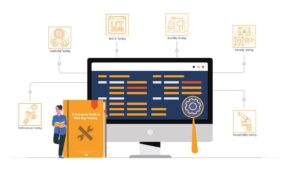Test your website’s functionality
Testing your website’s functionality is an important part of the auditing process. There are a few things you can do to make sure everything is working properly.
First, you’ll want to test all of your links. Make sure they’re all going to the right place and that they’re working correctly. You can use a tool like Google’s Webmaster Tools to check for broken links.
Next, you’ll want to test your forms. Make sure they’re working properly and that you’re receiving the information you need. You can use a tool like formstack to do this.
Finally, you’ll want to test your payment gateway. Make sure you’re able to process payments and that they’re going through correctly. You can use a tool like Stripe to test this.
By testing your website’s functionality, you can be sure that everything is working properly and that your users will have a good experience.
After reading this article, you should have a good understanding of how to audit your website like a pro. By using the tools and techniques described, you can improve your website’s overall performance and ensure that it is running smoothly. By regularly auditing your website, you can identify any potential problems early and take corrective action to prevent them from becoming bigger issues.
There are several ways to test a website’s functionality, and it typically involves checking various aspects of the site. Here are some steps and considerations for testing your website’s functionality:
-
Functional Testing: This involves checking if all the features and functions of your website work correctly. Test things like forms, buttons, links, navigation menus, and interactive elements.
-
Cross-Browser Testing: Ensure that your website functions properly across different web browsers such as Chrome, Firefox, Safari, and Edge. Browser compatibility can be a significant factor in user satisfaction.
-
Responsive Design Testing: Verify that your website is responsive and adapts well to various screen sizes and devices, including desktops, tablets, and mobile phones.
-
Performance Testing: Test your website’s loading speed and overall performance. Slow-loading pages can lead to a poor user experience and affect SEO.
-
Security Testing: Check for vulnerabilities and security issues such as SQL injection, cross-site scripting (XSS), and data breaches. Security is crucial to protect user data and maintain trust.
-
Content Testing: Review the website’s content for accuracy, spelling and grammar errors, and broken links. Ensure that images and media files load correctly.
-
Accessibility Testing: Ensure your website is accessible to all users, including those with disabilities. Test for compliance with accessibility standards like WCAG (Web Content Accessibility Guidelines).
-
User Experience (UX) Testing: Gather feedback from real users or conduct usability testing to evaluate how easily users can navigate and interact with your site.
-
Performance Under Load: Test how your website performs under heavy traffic or load conditions to identify bottlenecks and scalability issues.
-
Functionality Across Devices: Test your website on various devices, including smartphones, tablets, and different operating systems, to ensure it works consistently.
-
Database Testing: If your website relies on a database, ensure that data is being stored, retrieved, and displayed accurately.
-
E-commerce Functionality: If your website is an e-commerce site, thoroughly test the shopping cart, payment processing, and order fulfillment processes.
-
Forms and Data Submission: Ensure that forms on your website collect and process data correctly, and that users receive confirmation messages or emails upon submission.
-
Error Handling: Test how your website handles errors, such as 404 pages, and ensure that error messages are user-friendly.
-
Backup and Recovery Testing: Regularly backup your website and test the restoration process to ensure you can recover it in case of data loss or a security breach.
To effectively test your website’s functionality, consider using a combination of manual testing and automated testing tools. Additionally, involve a diverse group of testers to get a wide range of perspectives and feedback. Regular testing and maintenance are crucial to keeping your website running smoothly and providing a positive user experience.

